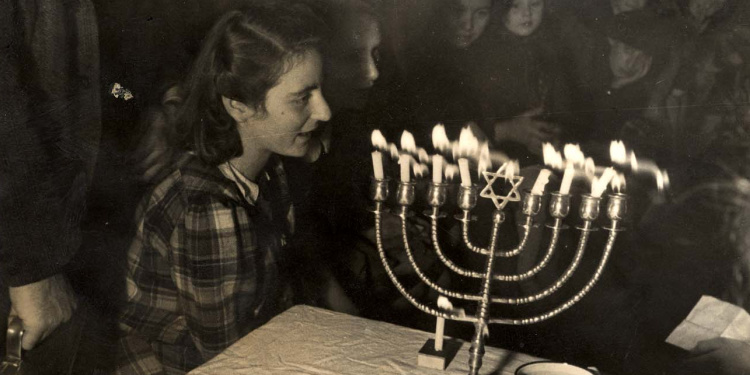Hanukkah, 1943
Stand for Israel | December 20, 2022

The above photo might be of any Hanukkah. A Jewish girl, in a festive dress, smiles after lighting the seventh candle of the menorah. Her loved ones surround her as they celebrate the Festival of Lights.
A ‘Normal’ Hanukkah
But the above photo doesn’t show just any Hanukkah. This is Hanukkah during the Holocaust. Yes, the photo, taken at Westerbork Concentration Camp in the Netherlands around 1943, might look “normal” or even festive. But that was the whole point of this particular Nazi camp—to lull the camp’s Jewish occupants into a sense of security.
At Westerbork, the Nazis provided the Jewish prisoners many facets of a normal life. Families were housed in two-room “cottages.” There was a school for the thousands of Jewish children to attend. There was an orchestra for musical inmates to join. There were restaurants for those at Westerbork to dine in. There was even a hairdresser.
An Evil Illusion
But all of this normalcy was an evil illusion. The Nazis needed the Jews they planned to murder to cooperate when being transported to their ultimate destination…
…and the ultimate destination for Jews after leaving Westerbork was Auschwitz-Birkenau. There, the majority of European Jews who disembarked the cattle cars were immediately murdered. Those who weren’t often fared little better—dying from starvation, overwork, or disease. The latter is what took the life of teenage writer and former Westerbork inmate, Anne Frank, who died of typhus after being moved from Auschwitz to Bergen-Belsen, yet another Nazi death factory.
Hanukkah, 1943
The identity of the little girl who has lit the menorah on the penultimate night of Hanukkah isn’t known. Most likely, she was murdered by the Nazis—simply for her faith—the same as any other faces in the photo.
But we do know the identity of the man who took the picture. Rudolf Breslauer was a German Jew who, before WWII, worked as a photographer and a printer in his native country. When Hitler’s anti-Semitic policies began, Breslauer and his family (just like the family of Anne Frank) fled to the Netherlands. But in 1942, the Breslauers—Rudolf, his wife Bella, their two sons Mischa and Stefan, and their daughter Ursula—were captured by the Nazis and sent to Westerbork.
At Westerbork, Rudolf was tasked by the camp commandant to document life on film. In the two years that Rudolf and his family were imprisoned there, he made a record of this dark chapter in Jewish history. In the fall of 1944, around the same time that the Frank family was also deported, the Breslauers were sent to Auschwitz. There, Bella and her sons were immediately sent to the gas chambers. Rudolf died there a few months later, shortly before liberation. But Ursula survived Auschwitz, survived the war, survived the Holocaust.
A Time of Light and Miracles
During this joyous holiday of Hanukkah, why do we share such a sad story? Well, we share this story because we have vowed to “Never Forget,” and that such evil will happen “Never Again.”
But we also share this story because Hanukkah is a time of light and miracles. Because, even during their darkest hour, the Jewish people remained faithful, and even when it seemed their light might be extinguished from the face of the earth, God would not let that happen. He would not let His children be forgotten.
And so as we light the candles of the menorah this Hanukkah, let us remember the faithful who lit candles during dark times, and let us be inspired by both their faith in God and the miracles that only He can provide.
